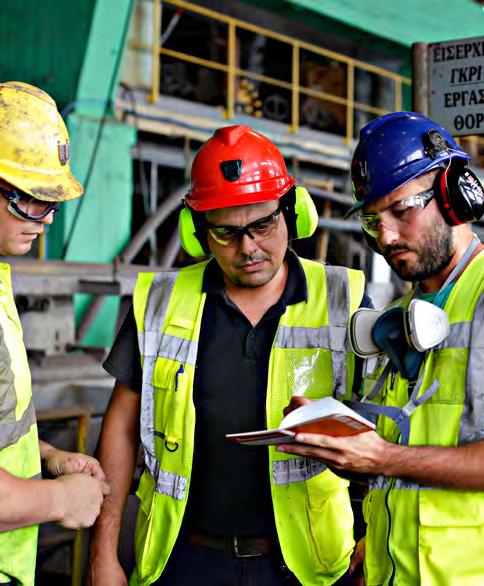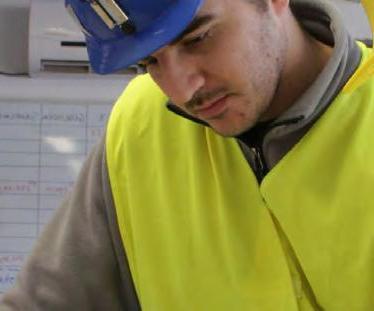6 minute read
4. Water & Tailings
Clean and readily available water is vital to human life and well-being of ecosystems and agriculture. Given its vital importance, access to water can be an issue for local communities, making responsible water use a key focus area for our operations, our environmental stewardship and relationships with local Stakeholders.
Managing water use and discharges
Good Practice
Efficient and Effective Water Management
We implemented the Basdekis Creek diversion in Olympias to prevent water from entering our underground mines and endanger our employees’ safety, maintain the local water quantity balance and maximize available clean water. Furthermore, we have developed a complete water management plan regarding Skouries mine water, which allows us to process and supply water to nearby communities for household use and irrigation.
Availability and access to water is critical for our operations, as we use water for mineral processing, dust suppression, slurry transport and personal consumption. Therefore, we: • Have extensively assessed our projects’ water-related impact, as part of our Environmental Impact Statements (EIS), which have been prepared by the Hellenic Authority for Geological and Mineral Research (EAGME) and are available online • Have set corporate targets to reduce freshwater consumption (i.e. water from privately owned drinking water drillings or municipal drinking water network) • Apply water management and recycling practices throughout our operations to strictly control water use across all sites and limit our impact on water sources • Monitor water use continuously through flow meters • Record water-related data at a granular level per site, which allows us to identify opportunities for increased efficiency at every stage of our operations • Take regularly water quality samples from groundwater and surface water sources within and around our sites, in order to compare them with the limit values defined by respective regulations and our operating permits • Display continuously water quality analyses results to
Stakeholders through our environmental monitoring platform (see Section 4.1) and also quarterly and annually communicate them to government and relevant authorities. Water sources: Majority of water we use is groundwater flowing into our underground mines, with small additional volumes of collected and processed contact water that falls into our facilities and municipal supplies. It must be noted that Skouries has been designed as a minimal water discharges site and most of our water use is from recycled water. Water processing and discharge: Our processing plants recycle and re-circulate used water to minimize freshwater consumption and allow for zero discharges. We collect, treat and reuse for industrial water uses any contact water that falls within our sites, which is then safely discharged back into the environment once water quality standards are met. We continuously monitor water quality before the treatment (e.g. pH, conductivity and metal content) at the exit of water treatment plants (i.e. final discharge point), in order to comply with the respective effluents discharge limits defined by the Joint Ministerial Decision of Approval of Environmental Terms regarding various discharge parameters (e.g. pH, Arsenic-As, Lead-Pb, Zinc-Zn, Manganese-Mn, Cadmium-Cd, Nickel-Ni, Total Suspended Solids-TSS). Furthermore, we: • Do not discharge contact water in our mines openly back into the environment • Use water-diversion channels to redirect non-contact surface water flows away from our sites, in order to ensure the quality and the safety of water downstream • Capture, store and reuse precipitation or groundwater entering our sites, apart from water evaporated.
0water sources significantly affected by our water withdrawal 0
water bodies and habitats significantly affected by our water discharges
2,629
thousand m3 of water recycled
23.5%
of our total water withdrawal recycled
58.9%
of total water usage recycled
96.6% of water used by our processing plants recycled 0 water discharge violations against limits on permits, standards and regulations
Managing tailings safely
Did you Know?
Tailings and Concerns
Tailings are created when mined ore is processed through water-based solutions, in order to separate valuable metals from surrounding rock. Management and storage of waste rock and the processed mineral residue (i.e. tailings) are critical issues for our industry, due to their social, safety and environmental impacts. The catastrophic tailings dam failure at Brumadinho (Brazil) in January 2019, shook the industry, without Eldorado Gold owning or managing that facility. As a result: • A coalition of investors led by the Church of England
Pensions Board and the Council of Ethics of the
Swedish National Pension Funds, with $13 trillion under management, launched the Investor Mining and Tailings Safety Initiative, calling for improved international standards and requested detailed public disclosure around management of tailings storage facilities, with Eldorado Gold disclosing information on tailings facilities in accordance with the Church of
England’s request • Members of the International Council on Mining and
Metals (ICMM) agreed to strengthen their tailings management and addressed key related areas in
ICMM’s Preventing Catastrophic Failure of Tailings
Storage Facilities position statement.
We take great care to manage tailings facilities in accordance with respective standards and regulations, in order to mitigate risks associated with tailings storage. We follow a general waste management plan for all our operations, part of which is the Kokkinolakkas Tailings Management Facility, and we: • Have developed plan and procedures with clear roles, responsibilities and communication channels related to tailings management • Conduct trainings on tailings management • Implement operational controls such as daily real-time monitoring of tailings facilities, routine inspections, risk assessments and regular maintenance programs • Have developed emergency preparedness and response plans • Review periodically tailings facilities design, construction, operation and closure plans • Receive oversight from Eldorado Gold for completion of any updates or corrective actions and identify opportunities for shared learning across operations. As part of our monitoring system, we are independently audited every 3 years by recognized tailings management and dam safety experts, with the most recent external audits conducted in 2020.
0
deficiencies or significant outstanding risks related to our tailings management practices
Implementing dry stack tailings
Good Practice
The Kokkinolakkas Tailings Management Facility
The Kokkinolakkas TMF is a state-of-the-art facility designed to safely and securely store dry stack tailings produced by our Olympias and Stratoni mines. The €100 million newly constructed facility employs a multi-layer impermeable liner, 24/7 monitoring systems and water-diversion and containment systems to maintain the structural integrity of the dry stack tailings, designed to withstand major seismic events.
Typically, tailings are stored in liquid or wet form, within purposefully constructed tailings dams. While properly constructed and maintained wet tailings facilities pose few risks, the liquid nature of tailings means that any containment structure failure may result in tailings escaping into the surrounding environment. To further mitigate risks to people and the environment, we have pioneered the use of dry stack tailings in Greece for our tailings management facilities. Dry stack tailings are produced when excess water is removed from tailings through filter-press technology, which leaves behind a dry, sand-like material, being more stable to manage and store. Water is then recycled for further use or treated and discharged into the environment, while tailings are transported and stored in tailings management facilities (TMFs), which insulate the surrounding environment and prevent tailings from entering or leaching directly into the soil or surrounding water sources. Tailings are then layered and compressed with heavy machinery, in order to stabilize the material. In April 2021, we acquired the Greek state’s approval to construct a dry stack tailings facility at Skouries.








